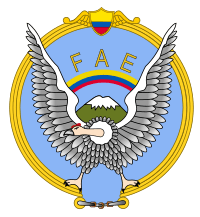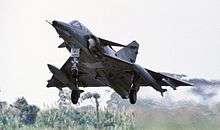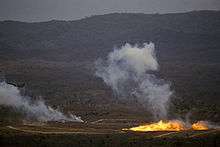Ecuadorian Air Force
The Ecuadorian Air Force (Spanish: Fuerza Aérea Ecuatoriana, FAE) is the Air arm of the Military of Ecuador and responsible for the protection of the Ecuadorian airspace.
| Ecuadorian Air Force | |
|---|---|
| Fuerza Aérea Ecuatoriana | |
 Ecuadorian Air Force seal | |
| Founded | 1920 |
| Country | |
| Branch | Air force |
| Role | Aerial warfare |
| Size | 6,389[1] 72 aircraft |
| Part of | Military of Ecuador |
| Engagements | Paquisha War 1981 Cenepa War 1995 |
| Commanders | |
| Current commander | Brigadier General Mauricio Campuzano Comandante General de la Fuerza Aérea Ecuatoriana |
| Notable commanders | Brig. Gral. Mario Augusto Naranjo Bardellini |
| Insignia | |
| Roundel |  |
| Fin flash |  |
| Aircraft flown | |
| Fighter | Atlas Cheetah, IAI Kfir |
| Helicopter | HAL Dhruv |
| Trainer | EMB 314 Super Tucano |
| Transport | C-130 |
Mission
To develop the military air wing, in order to execute institutional objectives which guarantee sovereignty and contribute towards the nation's security and development.
Vision
To be a dissuasive Air Force, respected and accepted by society, pioneering within the nation's "air-space" development.
History
The FAE was officially created on October 27, 1920. However, like in many other countries, military flying activity started before the formal date of birth of the Air Force. The history of Ecuador is marked by many skirmishes with its neighbour Peru. As a direct result of the 1910 Ecuador-Peru crisis the members of Club de Tiro Guayaquil decided to expand their sporting activities into aviation as well. Renamed Club de Tiro y Aviación, they started an aviation school. Cosme Rennella Barbatto, an Italian living in Guayaquil, was one of the very first members of Club de Tiro y Aviación. In 1912 Cosme Rennella was sent to his native Italy for training where he successfully graduated as a pilot. He later returned to Europe a second time in 1915, where he participated in World War I.[2] In 152 combat sorties he scored 18 victories, although only 7 were confirmed. When he returned to Ecuador, his experiences served as motivation for a reduced group of Ecuadorian pilots, who moved to the Aviation School in Turin, Italy, with the objective of graduating as the first Ecuadorian pilots of the nascent Ecuadorian Military Aviation.
By 1939 the Ecuadorian Air Force was still limited to about 30 aircraft and a staff of about 60, including 10 officers.[3] Military aviation did not start in earnest until the early forties when an Ecuadorian mission to the United States resulted in the delivery of an assortment of aircraft for the Aviation school at Salinas. Three Ryan PT-22 Recruits, six Curtiss-Wright CW-22 Falcons, six Fairchild PT-19A Cornells and three North American AT-6A Harvards arrived in March 1942, considerably boosting the capacity of the Escuela de Aviación at Salinas.
The 1950s and 1960s saw a further necessary buildup of the air force, gaining more units and aircraft. Meanwhile, efforts were made in enhancing the facilities at various airbases. In May 1961 the "First Air Zone" with its subordinate unit Ala de Transportes No.11 was founded. The "Second Air Zone" controlled the units in the southern half of Ecuador, Ala de Combate No.21 at Taura, Ala de Rescate No.22' at Guayaquil and Ala de Combate No.23 at Manta as well as the Escuela Superior Militar de Aviación "Cosme Rennella B." (ESMA) at Salinas.
The Ala 11 has its own commercial branch, like in many other South-American countries, the Transporte Aérea Militar Ecuatoriana (TAME). Besides the military transport aircraft, it also uses commercial airliners. Flying to locations off the beaten track, TAME provides an additional service to the people of Ecuador.

The FAE saw action on several occasions. A continuous border dispute with Peru flared up in 1981 and 1995.[4][5] Today the FAE faces the war on drugs as well as many humanitarian and logistic missions into the Amazon-region of the country. Nevertheless, being a middle-income country and supporting a relatively large air force is a burden.
Structure
This is the current structure of the Ecuadorian Air Force:[6]
- 21 Combat Wing (Ala de combate 21) - Taura Air Base
- 2112 Combat Squadron "Cheetah" (Esc. de combate 2112 "Cheetah") - operating Atlas Cheetah[7]
- 22 Combat Wing (Ala de combate 22) - Simon Bolivar Air Base
- 2211 Combat Squadron (Esc. de combate 2211) - operating Cessna 206
- 2212 Combat Squadron (Esc. de combate 2212) - operating TH-57
- 23 Combat Wing (Ala de combate 23) - Eloy Alfaro Air Base
- 2311 Combat Squadron "Dragons" (Esc. de combate 2311 "Dragones") - operating A-29 Super Tucano
- 11 Transport Wing (Ala de transporte 11) - Cotopaxi Air Base (part of Latacunga International Airport)
- 1111 Transport Squadron "Hercules" (Esc. de transporte 1111 "Hercules") - operating C-130H/L100-30
- 1112 Transport Squadron "Avro" (Esc. de transporte 1112 "Avro") - operating CASA 295
- 1113 Transport Squadron "Twin Otter" (Esc. de transporte 1113 "Twin Otter") - operating DHC-6 Twin Otter
- 1114 Transport Squadron "Sabreliner" (Esc. de transporte 1114 "Sabreliner") - operating Sabreliner
- Air Force Academy "Cosme Rennella" (Escuela Superior Militar de Aviacion "Cosme Rennella") - Salinas Air Base - operating Diamond DA20
Aircraft
Current inventory


| Aircraft | Origin | Type | Variant | In service | Notes | |
|---|---|---|---|---|---|---|
| Combat Aircraft | ||||||
| Atlas Cheetah | South Africa | fighter | Cheetah C | 9[8] | upgraded variant of the Dassault Mirage III | |
| Transport | ||||||
| Boeing 737 | United States | VIP | 1[8] | |||
| Boeing 727 | United States | transport / VIP | 1[8] | |||
| C-130 Hercules | United States | transport | C-130E/H | 3[8] | ||
| CASA C-295 | Spain | transport / SAR | 3[8] | |||
| DHC-6 Twin Otter | Canada | utility / transport | 2[8] | STOL capable aircraft | ||
| Super King Air | United States | utility | 350 | 1[8] | ||
| Military helicopter | ||||||
| Bell 206 | United States | utility / trainer | 8[8] | |||
| Leonardo AW119 | Italy | utility | Mk II[9] | 4[8] | ||
| Trainer Aircraft | ||||||
| EMB 314 Super Tucano | Brazil | advanced trainer | 17[8] | |||
| UAV | ||||||
| UAV-2 Hawk | Ecuador | surveillance | Indigenously-developed unmanned aerial vehicle[10] | |||
Armament

Air Defense
| Name | Origin | Type | In service | Notes | ||
|---|---|---|---|---|---|---|
| Mobile surface-to-air missile system | ||||||
| 9K33 Osa | Amphibious SAM system | 15[11] | ||||
| MIM-72 Chaparral | Mobile SAM system | 25[11] | ||||
| Air defense radar | ||||||
| AR-15M | Radar | 1[11] | Three-dimensional radar | |||
| AR-3D | Radar | 2[11] | Long-range radar | |||
| 36D-6 | Radar | 2[11] | Medium-range radar | |||
| AN/TPS-70 | Radar | 4[11] | Mobile S band phased array 3D radar Long-range radar | |||
| AN/TPS-78 | Radar | 1[11] | Passive 3D long-range electronic scanning radar Donated by USA | |||
| es:Radar Lanza | Radar | 4[11] | Long-range electronic scanning 3D radar Electronic/rotating mechanical radar | |||
| Oerlikon Skyguard II | Fire-control radar | 22[11] | Logistics support for Oerlikon anti-aircraft system | |||
| Self-propelled anti-aircraft artillery | ||||||
| ZSU-23-4 Shilka | SPAAG | 44[11] | All received from Nicaragua in 1997. Jane's Information Group. 2008-10-30.[12] Retrieved 2008-11-08. | |||
| M163 VADS | SPAAG | 50[11] | ||||
| Anti-aircraft artillery | ||||||
| Oerlikon GDF-003 | Twin Autocannon | 30[11] | Towed 35 mm towed automatic gun, operates alongside the Skyguard II system | |||
| M167 VADS | Rotary cannon | 30[11] | Automatic towed 20 mm automatic anti-aircraft gun | |||
| ZSU-23-2 | Twin Autocannon | 34[11] | Automatic towed automatic gun 23 mm caliber All received from Nicaragua in 1997. Jane's Information Group. 2008-10-30.[13] Retrieved 2008-11-08. | |||
| Bofors M1 | Anti-aircraft gun | 40[11] | 40 mm towed automatic anti-aircraft gun
| |||
| ZPU | Anti-aircraft gun | 128[11] | Towed anti-aircraft automatic gun 14.5 mm caliber
| |||
| M45 Quadmount | Anti-aircraft gun / Heavy machine gun | 226[11] | 4 x 50 automatic anti-aircraft gun 12.7 mm caliber,modernized with new systems, some are mounted on trucks Unimog and pickup CUCV II | |||
Air Infantry
Retired
Previous aircraft flown by the Air Force included the BAC Strikemaster, Cessna A-37 Dragonfly, Dassault Mirage 5, Dassault Mirage F1, English Electric Canberra, Gloster Meteor, Hawker Siddeley HS 748, Republic P-47 Thunderbolt, SEPECAT Jaguar, HAL Dhruv.
See also
- Military of Ecuador
References
- A Comparative Atlas Of Defence In Latin America / 2014 Edition
- Franks, Norman; Guest, Russell; Alegi, Gregory. (1997) Above the War Fronts: The British Two-seater Bomber Pilot and Observer Aces, the British Two-seater Fighter Observer Aces, and the Belgian, Italian, Austro-Hungarian and Russian Fighter Aces, 1914–1918: Volume 4 of Fighting Airmen of WWI Series: Volume 4 of Air Aces of WWI. Oxford: Grub Street. pp. 155-156.
- Schnitzler, R.; Feuchter, G.W.; Schulz, R., eds. (1939). Handbuch der Luftwaffe [Aviation Manual] (in German) (3rd ed.). Munich and Berlin: J. F. Lehmanns Verlag. p. 64.
- "Peru vs. Ecuador; Alto-Cenepa War, 1995". Retrieved 24 December 2014.
- "Ecuador Air Force". Retrieved 24 December 2014.
- Eric Katerberg & Anno Gravemaker, Force Report: Ecuador Air Force, Air Forces Monthly, July 2008 issue.
- http://www.thefreelibrary.com/Ecuador%3A+Denel+hopes+Ecuador+Cheetah+buy+will+be+complete+by+year-end-a0209503691
- "World Air Forces 2020". Flightglobal Insight. 2020. Retrieved 14 April 2020.
- "Ecuadorian AW119 delivered". AirForces Monthly. Key Publishing. May 2019. p. 22.
- "Ecuador; Air Force receives indigenously developed UAV". Dmilt.com. 16 January 2014. Archived from the original on 16 January 2014. Retrieved 18 April 2020.
- "Peace Research Institute". Stockholm International Peace Research Institute. 2017. Retrieved 31 March 2018.
- http://www8.janes.com/Search/documentView.do?docId=/content1/janesdata/yb/jlad/jlad0057.htm.
- http://www8.janes.com/Search/documentView.do?%7C-docId=/content1/janesdata/yb/jlad/jlad0057.htm.